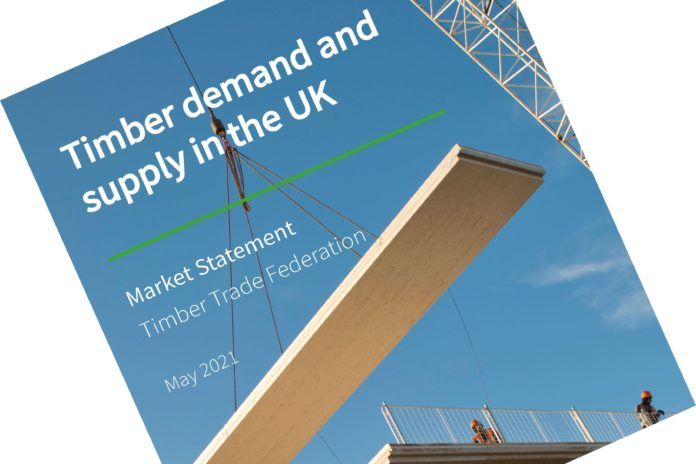The Timber Trade Federation (TTF) has released a market statement which provides a slightly longer perspective on supply and demand of timber in the last three years, outlining the impact the pandemic and Brexit have had on trading and what to expect.
Current situation
Timber is still being imported and produced in the UK and customers with forward purchasing strategies are receiving their materials. Regular dialogue on forward requirements is encouraged between purchasers and their suppliers, wherever they sit in the supply chain.
However, due to the pandemic, and high domestic and international demand, the formerly abundant stock levels enjoyed by buyers in the UK have not been re-built since the beginning of 2020.
Supply is set to tighten as 2021 progresses, with sawmills in Europe entering a typical period of shut down for repair, maintenance and holidays in June/July. What’s more, high demand continues, particularly for structural and other softwood materials, panel products and hardwoods, around the world.
Meanwhile, housebuilding in the UK was initially shut down by the pandemic but is now catching up, further pressuring supplies. Government emphasis on revival in construction as a lead into expanding the economy is also influencing the demand curve.
Furthermore, other countries are prepared to pay higher prices than traditionally agreed by UK timber purchasers, heightening the perception of value. UK-grown timber supplies are insufficient to replace the level of imported timber demanded by UK construction and refurbishment.
Brexit-related factors are also affecting importers. Around 80% of the softwood used in Britain’s building, fit-out and refurbishment sectors comes in from countries in the EU and further afield on the continent. This rises to around 90% in newbuild housing.
Timber in 2020
Prior to 2020, the two abortive attempts at Brexit had seen both suppliers and wood users respond to uncertainty by stock-piling large volumes of timber and wood products, creating artificially high stock availability. As each attempt at Brexit failed, it created artificially low pricing, reflecting the extreme over-supply in the marketplace, which then passed through the supply chain.
Pre-pandemic, UK wood buyers, from major house builders to householders, benefitted from abundantly available supplies, available from many points along the supply chain.
The actual volume of softwood timber imported during 2020 was more than the total for the economically active year of 2019. The market dynamics, however, changed substantially in 2020.
Working from home in the UK and around the world also created unprecedented demand for timber for DIY projects and home/garden refurbishments.
Initial COVID-forced shutdowns in some European sawmills, combined with a high global demand for timber in general, meant that normally abundant stocks on the ground in Britain could not be re-built.
Unprecedented demand continued throughout winter 2020 – a time at which companies would normally replenish stocks for the new building season following on in spring. This replenishment was not able to take place and although material was coming into the UK regularly, it was immediately going out for delivery.
However, by the end of 2020, no unsold stock existed in the UK. Customers with forward planning and purchasing strategies were able to receive their materials, thus much of the major housebuilding sector was still able to function, despite the massive uplift in demand.
Looking ahead for 2021
Despite timber suppliers’ efforts, demand is currently higher than can be swiftly gratified by existing production facilities and available input supplies across the UK and Europe.
The Builders Merchants Building Index (BMBI) showed sales of timber and joinery products up over 18% in January 2021 compared to January 2020, indicating the continuing strength of domestic refurbishment and building demand.
Meanwhile, housebuilders continue to ramp up work on-site. The value of construction projects (under £100 million) starting on-site in the three months to April 2021 was 30% higher than the same period last year, according to Glenigan.
The Federation of Master Builders’ Q1 State of the Trade report shows the fastest rise in enquiries for 10 years; repair, maintenance and refurbishment work is seeing the strongest revival.
Meanwhile, some timber-producing countries traditionally supplying the UK have instituted log export bans, which puts additional pressure on supplies. The Republic of Ireland is having its own internal difficulties over log harvesting, impacting the UK construction supply chain. Higher log prices are already being paid by sawmills at home and abroad; higher costs are then passed on through national and international supply chains.
Brexit-related issues will continue to cause supply problems, while difficulties with due diligence paperwork and new plant health requirements, plus the situation with movements to and from Northern Ireland continue unabated.
Commenting on the report, David Hopkins, chief executive of the Timber Trade Federation, said: “In our view, the market position should be phrased as a demand rather than as a supply situation.
“However, the surge in demand for construction materials this year means customers may not be able to purchase timber as readily off the shelves as they have been used to.
“We advise users of timber to work closely with suppliers on their purchasing strategies, and to take a forward-looking perspective on securing supplies.
“This approach will remain important, as recent reports have shown we can expect demand to continue to be high, particularly for structural and other softwood materials.”




